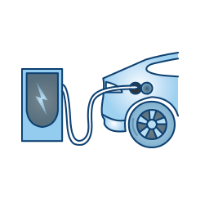Courses by Software
Courses by Semester
Courses by Domain
Tool-focused Courses
Machine learning
POPULAR COURSES
Success Stories
Week-11 Challenge: Braking
Braking Objectives: To calculate the energy required for braking for a defined driving cycle. To explain why electric motor can’t develop braking torque at high speed similar to starting? How electric and mechanical brakes are coordinated? To make a MATLAB program which plots contour of given motor speed, torque…
Avinash Dhotre
updated on 17 Jul 2021
Braking
Objectives:
- To calculate the energy required for braking for a defined driving cycle.
- To explain why electric motor can’t develop braking torque at high speed similar to starting? How electric and mechanical brakes are coordinated?
- To make a MATLAB program which plots contour of given motor speed, torque and efficiency values. Attach the code as a .m file attach a screenshot of all the plots.
Introduction:
Braking is the process of controlling the velocity of an object by inhibiting its motion. An object in motion possesses kinetic energy and to bring the object to a stop this kinetic energy must be removed. Removing the kinetic energy can be accomplished by dissipating the energy to the atmosphere through friction or by converting it into another form of energy. The most common type of braking is a mechanical brake which inhibits motion through friction brake pads. A mechanical brake applies a friction force to convert the kinetic energy of the vehicle into thermal energy which then dissipates into the atmosphere. Braking systems which don't use friction are referred to as regenerative braking systems (RBSs). In RBSs, the kinetic energy is converted into other forms of useful energy, which can be stored for later use, increasing fuel efficiency.
Q1. For a defined driving cycle, calculate the energy required for braking.
The braking energy is the energy generated when the vehicle (travelling at a certain speed) comes down to zero speed. The braking power can also be calculated when the time taken for deceleration is also considered.
To calculate the energy required for braking first, the drive cycle is defined in an excel sheet and a plot is made.
Using the plot, the values from the braking regions of the vehicle are taken.
The plot from the defined drive cycle is given below:

From the plot, it is seen that the drive cycle consists of 6 braking regions. The initial and final values of the velocities along with the time required are given below.
| Braking Region | Initial velocity (kmph) | Final velocity (kmph) | Time required (s) |
| 1 | 60 | 40 | 3 |
| 2 | 50 | 30 | 3 |
| 3 | 80 | 20 | 11 |
| 4 | 60 | 40 | 3 |
| 5 | 50 | 30 | 3 |
| 6 | 80 | 0 | 7 |
The above values are used to calculate the energy required using the formula
EBraking=12×m×(v2i-v2f)
where, m = Mass of the vehicle in (Kg) = 1000 kgs
vi = Initial velocity of vehicle in (m/s)
vf = Final velocity of the vehicle in (m/s)
With the above values, the deceleration values and total braking energy requirement of the vehicle are calculated using the excel calculator. The calculations are as given below.
Link for Excel sheet: Energy required for braking-Calculation
| Braking Region | Initial velocity (kmph) | Final velocity (kmph) | Time required (s) | Deceleration (m/s^2) | Energy required (J) | Braking power (kW) | Braking energy (kWh) |
| 1 | 60 | 40 | 3 | 1.85 | 277778 | 92.59259259 | 0.02572016461 |
| 2 | 50 | 30 | 3 | 1.85 | 222222 | 74.07407407 | 0.02057613169 |
| 3 | 80 | 20 | 11 | 1.52 | 833333 | 75.75757576 | 0.02104377104 |
| 4 | 60 | 40 | 3 | 1.85 | 277778 | 92.59259259 | 0.02572016461 |
| 5 | 50 | 30 | 3 | 1.85 | 222222 | 74.07407407 | 0.02057613169 |
| 6 | 80 | 0 | 7 | 3.17 | 888889 | 126.984127 | 0.03527336861 |
| Total braking energy required | 0.1489097322 | ||||||
∴ The total braking energy required = 0.148 KWh
Q2. Why electric motor can’t develop braking torque at a high speed similar to starting?
Regenerative Braking:
The motor moving at high speed then brakes are applied the motor cut down the battery source but the motor continues to run because of the moment of inertia. As the motor runs in a magnetic field, the back emf is developed which produce negative torque. This negative torque results in braking.
During braking the motor act as a generator that recharges the battery. The kinetic energy of the vehicle is converted into electrical energy and stores in the battery. In a conventional IC engine vehicle, the kinetic energy is dissipated only in the form of heat.
The maximum regenerative braking force produced by an electric motor is closely related to the electric motor’s speed.
During low speed (lower than its base speed), the torque produced by the motor is maximum and almost constant and motor operates in constant torque region. Therefore, it has higher acceleration power which is possible.
However, at high speed (higher than its base speed), the maximum torque decreases hyperbolically with its speed. Therefore, the mechanical brake torque at a given vehicle deceleration varies with vehicle speed.
Motor efficiency and continuous torque capability:

- From the above figure, it can be understood that the torque-efficiency curves of both operations are different. Electric motors have high starting torque, almost constant torque available at a lower speed (speeds below base speed) and at higher speeds (speeds above base speed) this torque tends to decrease hyperbolically, this applies to all the operating quadrants of the motor.
- At high speeds, the Back EMF is so close to Vbus that the applicable Motor torque gets limited. Then, the bigger the Friction torque + Additional load is, the smaller the Acceleration torque becomes.
- Peak Acceleration Torque and Peak Deceleration torque are not equal for Electric Vehicle Motor. Acceleration is usually higher, at low speed and torque is also higher. But, at high speed the value of the torque is lower.
- For example at the starting of acceleration of motor the maximum constant torque is 7 N-m. But when speed is higher than the base speed so at these high speed if driver want to apply brake then motor must produce negative torque and that value if plotted is not same as acceleration torque at starting, i.e the plotted value will be less than -7 N-m or around -4 N-m.
- This is because when motor operating above base speed then it is operating in field weakening region, and we must know that torque value is compromised.
- Thus, electric motor can’t develop braking torque at a high speed similar to starting.
There are some limitations due to which electric motor can’t develop braking torque at a high speed similar to starting.
Motor Limitation:
As mentioned above, when motor operating above base speed then it is operating in field weakening region, and we must know that torque value is lower. Therefore regenerative braking cannot happen so effectively that we get all the power to the battery. This is motor limitation.
Battery Limitation:
During acceleration the batteries discharge at double rate (2C). Usually with chemistry and other limitations of battery life cycle the charging rates are are as high as 1C only. So battery charging rate is quite lower compared to to their peak discharge rate. This is battery limitation.
Power Converter Constraint:
The power converters are bi-directional as they use the regenerative braking to charge the battery and if the power converters are complex or less efficient at high speed then braking torque gets affected.
- How electric and mechanical brakes are coordinated?
Electrical Braking:
Electrical braking can be done by many methods such as:
- Unblancing the input phases of current to the motor.
- Using transistors in H-bridge configuration to reverse the motor direction in order to reduce speed.
- Implimenting regenerative braking system by using bi-directional power converters.
- Regenerative braking converts much of the energy to electrical energy, which may be stored for later use.
Mechanical Braking:
Mechanical brakes commonly use friction between two surfaces pressed together to convert the kinetic energy of the moving object into heat, though other methods of energy conversion may be employed. The friction between the surfaces are produced using pressurized air or pressurized oil which are commonly known as air brake and hydraulic brake respectively.
Coordination of electrical and mechanical braking:
Two types of brake control strategies are used to coordinate the electrical brake and mechanical brake are:
- Series control strategy
- Parallel control strategy
The comparison of the control strategies are shown in the below figure.
In the figure it is seen that, according to the amount of brake pedal travel of the vehicle, the mechanical brakes and regenerative brake are applied.

1. Series control strategy
When the brake is applied according to the brake pedal travel the front wheel friction brake, the rear wheel friction brakes and the regenerative brakes are applied one after another. As the braking requirement increases the frictional brakes are used accordingly.
For low speeds of the vehicle, regenerative braking is used but it may be limited according to the SOC (state of charge) of the battery. As the speed of the vehicle increases the rear wheel frictional brake will be applied, if the braking requirement in not satisfied yet then the front wheel frictional brake is also used.
The coordination of the series control braking can be done with preference to comfort of braking (or) energy storage.
2. Parallel control strategy
When the brake is applied according to the brake pedal travel the front wheel friction brake, the rear wheel friction brakes and the regenerative brakes are applied simultameously. The higher the travel of the brake pedal the higher the amount of braking will be done.
The braking energy is distributed in the following manner,
Rear wheel friction brake > Front wheel friction brake > Regenerative brake
- Electric driven intelligent brake (EDIB)
EDIB is a brake control strategy which is developed by NISSAN. The EDIB (Electric Driven Intelligent Brake) allows and controls optimization of the regenerative brake and regular friction brake (hydraulic brake).
After stepping on the brake pedal, the system produces natural and adequate braking force that corresponds to the operation. The amount of energy regeneration also needs to be increased as much as possible.


EDIB (Electric Driven Intelligent Brake) controls the regenerative brake and friction brake to support both of these requirements. Further, it also controls the reactive force from the pedal in order to unify the feeling when stepping down on the pedal and the sense of deceleration.
- At low speed use of regenerative braking is higher.
- At high speed or initial braking period combining both regenerative and mechanical braking.
Technology Configuration:
When the driver steps on the brake pedal, the stroke sensor detects operation of the brake. That information is communicated to the ECU and controls the motor. The motor engages the piston and amplifies the friction brake's pressure (hydraulic pressure). Through optimum control of the friction brake's hydraulic pressure, the energy regeneration outcome is maximized.
Q3. Make a MATLAB program which plots contour of given motor speed, torque and efficiency values. Attach the code as a .m file attach a screenshot of all the plots.
A Motor have various types of losses happening inside. The various types of losses are:
Copper Losses - I2×R, where R is the Armature resistance and we say that torque is proportional to current, this copper loss can be considered as kc×T2,where kc is to take care of resistance of brushes and also take care of flux and its effect.
Copper losses = kc×T2
Iron Losses - Iron Losses are nothing but Magnetic losses, which is denoted as ki×ω, where ki factor is based on the Magnetic field effect. Permanent Magnets have constant magnetic field and this Iron losses is based on the value of ki and this are going to change according to the speed. At Various Speed have different value of Back EMF and that is going to affect the Iron Losses.
Iron Losses= ki×ω
Windage Losses - This is a Mechanical or friction of Windage losses. This is based on size of shape of motor and the amount of windage losses that the motor is going to experience.
Windage Losses= kw×ω3
Constant Losses - This is denoted as C.
Total Losses - The Total Losses are considering the above four losses and denoted as:
Total Losses= kc×T2+ ki×ω+ kw×ω3+C
All Motors are model as per the above equation of losses. This above equation is not only applicable for Permanent Magnet DC Motor, but other motors as well like induction motor
MATLAB program:
MATLAB program file: MATLAB Code (.m File)
%%Program to plot efficiency contours for electric motors.
clear all
close all
clc
%Set up an array for range of the motor speed & torque
x = linspace (1,1000); %Motor Speed | N.B. rad/sec
y = linspace (1,300); %Torque | 0 to 40 N-m
%Input constant values of Motor losses
kc = 0.2; %For Copper losses
ki = 0.008; %For Iron losses
kw = 0.00001; %For Windage losses
const = 20; %For Constant motor losses
% Make a mesh
[X,Y] = meshgrid(x,y);
Output_power = (X.*Y); %Power = Torque x Speed
B = (Y.^2)*kc; %Copper losses
C = X.*ki; %Iron losses
D = (X.^3)*kw; %Windage losses
%Input power = Output power + Motor losses
Input_power = Output_power + B + C + D + const;
Z = Output_power./Input_power; %Efficiency of the motor
%We now set the efficiencies for which a contour will we plotted
V = linspace(0.65,0.95,10);
[C,h]= contour (X,Y,Z,V);
xlabel ('Speed (rad/sec)')
ylabel ('Torque (N-m)')
clabel (C,h)
colorbar
hold on
title ('Motor Speed-Torque & Efficency contour lines')
box on
grid on
%%End of program
Explanation for above Program:
1. The program starts with the clearing all the previous data, window or workspace values. To calculate the losses of the motor, we need the values of speed and torque. An array is defined to set a range for these values.
clear all
close all
clc
%Set up an array for range of the motor speed & torque
x = linspace (1,1000); %Motor Speed | N.B. rad/sec
y = linspace (1,300); %Torque | 0 to 40 N-m2. All the values of constant are defined which are needed to calculate the overall loss in the motor.
%Input constant values of Motor losses
kc = 0.2; %For Copper losses
ki = 0.008; %For Iron losses
kw = 0.00001; %For Windage losses
const = 20; %For Constant motor losses3. Total loss of the motor is calculated with the efficiency. A dot matrix is used as the values of Speed & Torque are in an range (array).
% Make a mesh
[X,Y] = meshgrid(x,y);
Output_power = (X.*Y); %Power = Torque x Speed
B = (Y.^2)*kc; %Copper losses
C = X.*ki; %Iron losses
D = (X.^3)*kw; %Windage losses
%Input power = Output power + Motor losses
Input_power = Output_power + B + C + D + const;
Z = Output_power./Input_power; %Efficiency of the motor4. Now, plot the contour for the motor speed, torque & efficiency for the defined range of speed & torque.
%We now set the efficiencies for which a contour will we plotted
V = linspace(0.65,0.95,10);
[C,h]= contour (X,Y,Z,V);
xlabel ('Speed (rad/sec)')
ylabel ('Torque (N-m)')
clabel (C,h)
colorbar
hold on
title ('Motor Speed-Torque & Efficency contour lines')
box on
grid on
%%End of program
Output:

The above Plot shows the Motor Speed-Torque Efficiency Contour Plot. The innermost contour line is group of efficiencies which has highest value of the efficiency as 95%, because here the height is maximum and another point is denoted outermost contour line is contain group of efficiencies which is the lowest value of efficiency as 65%, because here the height reduces. Increasing efficiency order as going inward and Decreasing efficiency order as going outward.
From the output graph we can notice that only at particular speed and torque the efficiency is at maximum i.e. 90 %. where Speed x = 323.909 rad/sec @ 40 N-m Torque. As the Speed increases the efficiencies of the motor will be reduced.
Hence, to attain maximum efficiency of the motor has to constantly run at around 324 rad/sec speed @ 40 Nm.
References:
https://www.nissan-global.com/EN/TECHNOLOGY/OVERVIEW/edib.html
Files attached:
For Q1 - Energy required for braking-Calculation
For Q3 - MATLAB Code (.m File)
Leave a comment
Thanks for choosing to leave a comment. Please keep in mind that all the comments are moderated as per our comment policy, and your email will not be published for privacy reasons. Please leave a personal & meaningful conversation.
Other comments...
Be the first to add a comment
Read more Projects by Avinash Dhotre (32)
Week-11 Challenge: Braking
Braking Objectives: To calculate the energy required for braking for a defined driving cycle. To explain why electric motor can’t develop braking torque at high speed similar to starting? How electric and mechanical brakes are coordinated? To make a MATLAB program which plots contour of given motor speed, torque…
17 Jul 2021 01:19 PM IST
Week-7 Challenge: DC Motor Control
Aim: To study DC Motor Control Objectives: 1. A. Explain a MATLAB demo model named ‘Speed control of a DC motor using BJT H-bridge’. B. Comment on the armature current shoot-up from the scope results. C. Refer to the help section of ‘The Four-Quadrant Chopper DC…
23 May 2021 12:20 PM IST
Week-6 Challenge: EV Drivetrain
Aim: Challenge on EV Drivetrain Objectives: To understand the types of power converter circuits are employed in an electric and hybrid electric vehicle. Duty ratio and power electronics on the vehicle control. To explain briefly about the author's perspective on induction versus dc brushless motors by Wally Rippel, tesla.…
17 Apr 2021 10:58 AM IST
Week 10: Project 1 - FULL HYDRO case set up (PFI)
Aim: Full Hydro Case Setup for Port Fuel Injection(PFI). Objective: To find out the following with the provided engine input: 1. To calculate the compression ratio of this engine. 2. To specify the need a wall heat transfer model and To describe why can't we predict the wall temperature from the CFD simulation?…
11 Dec 2020 12:20 PM IST
Related Courses





Skill-Lync offers industry relevant advanced engineering courses for engineering students by partnering with industry experts.
Our Company
4th Floor, BLOCK-B, Velachery - Tambaram Main Rd, Ram Nagar South, Madipakkam, Chennai, Tamil Nadu 600042.
Top Individual Courses
Top PG Programs
Skill-Lync Plus
Trending Blogs
© 2025 Skill-Lync Inc. All Rights Reserved.










